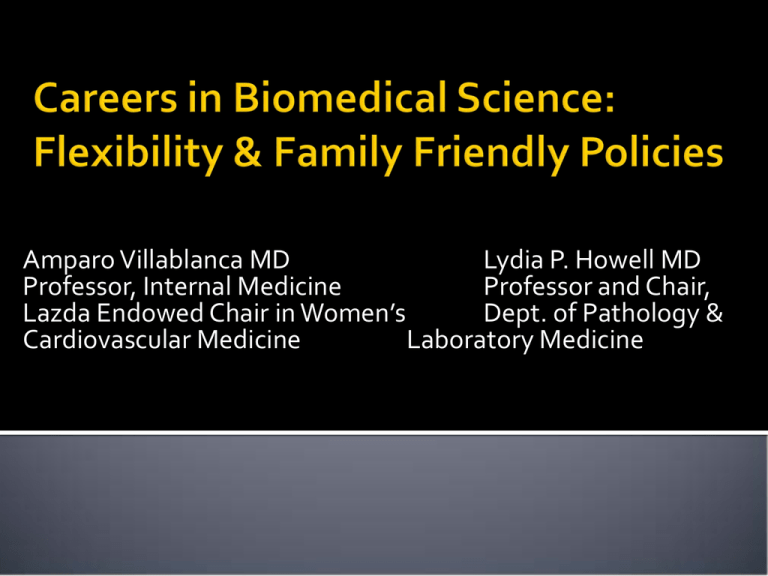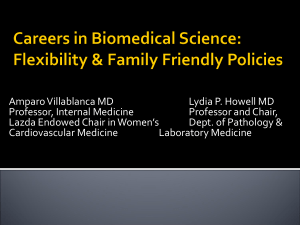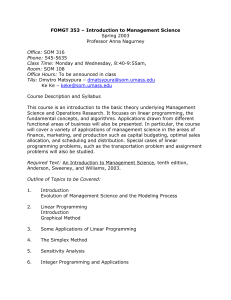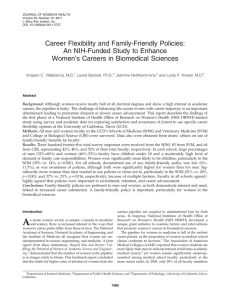Amparo Villablanca MD Lydia P. Howell MD Professor, Internal Medicine Professor and Chair,
advertisement

Amparo Villablanca MD Lydia P. Howell MD Professor, Internal Medicine Professor and Chair, Lazda Endowed Chair in Women’s Dept. of Pathology & Cardiovascular Medicine Laboratory Medicine To say thank you for participating in the survey on your awareness, use, and attitudes toward SOM policies for career flexibility. To share: Why we are doing this study. Why it is important to all faculty. Some preliminary results. To educate on our policies, so that they can be accessed and used! Generational issues: Younger generations are more interested in family and a well-rounded life Older generations are burned out and want balance. Gender issues: National workforce: 40% = women; many are the sole bread-winner for families. Under-representation by women in medicine and science careers: even though 50% in medical school and PhD programs. Asante EO. Managing in the generation gap. Radiol Manage. 2001; 23:48-49. Bickel J, Brown AJ. Generation X: Implications for faculty recruitment and development in academic health centers. Acad Med 2005; 80:203204. Borges NJ et al. Comparing Millennial and Generation X medical students at one medical school. Acad Med 2006; 81:571-586. Howell LP, et al. Multigenerational challenges in academic medicine: UCDavis's responses. Acad Med 2005; 80:527-532 Howell LP, et al. Generational forecasting in academic medicine: a unique method of planning for success in the next two decades. Acad Med 2009; 84:985-993. Borges NJ, et al. Differences in motives between Millennial and Generation X medical students. Med Educ 2010; 44:570-576. Average annual turnover of new hires: 24% A more insightful perspective: Over 5 years, how many new hires are retained? Of MDs hired in 1995: 83% retained after year 1 72% retained after year 2 64% retained after year 3 59% retained after year 4 55% retained after year 5 ▪ Waldman JD et al. Measuring retention rather than turnover. Human Resources Planning 2004; 27:6-9. Cost per physician at a major medical center: To hire: To Train: Cost of efficiency (learning curve): TOTAL: $ 36,374 89,800 86,501 $213,044 ▪ Waldman JD et al. The shocking cost of turnover in healthcare. Healthcare Manage Rev 2004; 29:2-7. Cost for basic scientist: $ 1,047,000 Beyond Bias and Barriers: Fulfilling the Potential of Women in Academic Science and Engineering Documents significant gender gaps in academic pipeline. Women : ▪ Receive 20+% of life science doctoral degrees but have <15% of academic positions. ▪ Paid less, promoted more slowly, hold less leadership positions. Concludes that sources of gaps are unconscious, pervasive bias. Solutions include: Additional institutional support for working parents Flexibility of time: Leaves for child-bearing, -rearing, adoption, personal medical reasons, death/care of loved ones, disability. ▪ UC is a leader in leave policies; first established in 1988. Extension of the “clock” for promotion. Part-time faculty appointments. Alternative work schedules or job sharing. Flexibility of place: Telemedicine, telecommuting, video conferencing. Programs that link business outcomes with flexible arrangements. Previously, depts created their own leave policies in their compensation plan. This was problematic since: “Wealthy” departments offered better leaves than less wealthy. Depts with few women offered minimal leaves for child-bearing and family leaves. Created a culture of “haves” and “have nots” Some depts offered leaves they couldn’t afford! Villablanca and Howell: NIH R01,$1.27M, 4 year Study awareness, attitudes and use of flexible career policies. Are there key elements of family friendly and career flexibility policies that serve as a model for improved faculty satisfaction and career success? Baseline survey re: satisfaction, awareness and use of career flexibility options. Implement an Accelerator intervention: Improve awareness of, access to, and use of family-friendly policies; Assess its impact over a 3-years re: professional outcomes, awareness and use of options, satisfaction Explore which personal and professional characteristics affect: performance, awareness, use of options, and personal satisfaction. Compare with other UCD biologic science schools: School of Vet Med and College of Biologic Sciences Child-bearing Adoption/ Placement* Faculty member giving birth Faculty with >= 50% responsibility of childcare for child < 5 yrs old. Full-time leave for 12 weeks maximum Full-time leave for 12 weeks maximum Salary: Full salary Full Salary Healthcare Benefits: Maintained Maintained Who: Time and Duration: *only one parent may use the adoption leave Family & Medical Leave Parental Leave Active Service Modified Duties 1+ yr univ. service, responsible Any faculty member 1+ yr univ. service, Time and Duration: Full-time leave for 12 weeks maximum Full-time leave for 1 year maximum (other leaves included) Negotiated part-time for 12 weeks maximum Negotiated % reduction, renewable at re-appt. time Salary: For first 3 months None Full base, Y reduced proportional to duty reduction Base and Y reduced proportionate to duty reduction Healthcare Benefits: Maintained None Maintained Maintained if >=50% appt. Who: Part-time Appointment At chair’s discretion, responsible for >=50% and academic/ business needs childcare Childbearing or adoption/placement leave: 12 wks, full salary, benefits maintained. If more full-time leave is desired: FMLA; 12 additional wks, no salary, benefits maintained. If more full time leave is desired: Parental leave; up to 1 year (inclusive of time above); no salary or benefits, but job is held. Temporary part-time after any of the above: Active duty modified service: Full X but prorated Y salary; full benefits, max = 12 wks Using paid sick leave Family and Medical Leave Who: Faculty with unused Faculty with > 12 months university sick leave service Time and Duration: Full-time leave for 5 days maximum Full-time leave for 12 weeks maximum Salary: Paid Paid for first 3 months Health Benefits: Maintained Maintained Extending the Promotion Clock Deferral of Merit or Promotion Reviews Who: Assistant professors with >=50% responsibility for care of child <5 yrs, or who has medical leave Those who experienced leaves for childbearing, adoption or placement, for medical reasons; or for other significant reasons which impacted productivity Time: One year extension for each event above, up to 2 years maximum extension Deferrals = One year each, can be requested more than once Medical Leave and Disability Standard salary coverage by depts during first 180 days, SOM-purchased long-term disability after 90 days to cover 60% of Y salary, employee purchased disability begins after 180 days to cover 70% of X salary. 1st 90 days of waiting period 100% pay 1-3 mos Long Term Disability (CIGNA) 60% of Y, $7,500/mo. Max (benefits begin @ 90 days as of 9/1, 2cnd 90 currently begin @ 180 days) days of waiting period 100% X 4-6 mos Supplemental Disability (LIBERTY MUTUAL) Supplements other income to 70% of X $10,000/mo. maximum Disability Date Supplemental Disability Benefits begin @ 6 Months Note: Disability insurance benefits as of 2010, and subject to contracts with insurers Baseline Survey Response rate: <50 years old: Rank: 42% (n =325/779) 53% <10 yrs at UCD: Race: Gender: 61% 27% non-white 38% female, 62% male 31% Assistant 24% Associate 44% Full Marital status similar between men and women- over 90% married or in committed relationships. Women more likely to be childless (35% women vs 14% men), in SOM only. Men more likely to have no other family responsibilities and children >18 years old living out of the home. 33%-42% of men and women faculty report other family care responsibilities (elderly parents, grandchildren, etc.). Faculty rate their level of family responsibilities as ‘significantly demanding’ to ‘very demanding’ Child bearing leave 5 Modified Duties Extension of time clock Deferral of reviews * 4 * Reduction to part-time Mean Score * 3 2 Score: 1 unaware 3 mildly aware 5 very aware 1 0 Male *p<0.05 Female SOM Male Female SVM Male Female CBS benefits in last 10 years denied use Actual Use Self-Report Use 15 ** 100 * *** * wanted to use wanted to use but chose not to took time off but not as much time as s/he felt s/he needed *** *** * 10 Percent Percent 75 *** 50 5 25 0 0 Male Female SOM Male Female SVM *p<0.05, **p<0.01 ,***p<0.001 Male Female CBS Male Female SOM Male Female SVM Male Female CBS Note: no significant differences for schools except for “wanted to use but didn't”. Reasons by School SOM Reasons by Gender 50 SOM 50 Male SVM 40 30 20 40 Percent Respondents Percent Respondents Female CBS ** 30 ** 20 10 10 0 0 † p≤ 0.05 female > male in CBS only 5 SOM 4.5 SVM 4 CBS *** Mean Score 3.5 3 2.5 2 1.5 1 0.5 0 Recruitment and retention † Career advancement † Career/family balance ***p<0.001 Score 1= strongly agree,5 = strongly disagree † stronger agreement for females vs. males in SOM only (p<0.001) Ability to meet respondents' needs Departmental support in policy application Overall career satisfaction Satisfaction with Family Friendly Benefits by Gender * Percent Respondents 100 ** * ** Increased satisfaction due to existence Increased satisfaction due to future use ** No change in satisfaction 80 Concern about reaction of colleagues 60 Fair implementation 40 20 0 Male Female SOM *p<0.05, **p<0.01 Male Female SVM Male Female CBS On-site Child Care Helpful Resources Peer coaches * 50 Workshops *** *** Percent Respondents 40 30 20 10 0 Male Female SOM *=p<0.05, ***=p<0.001 Male Female SVM Male Female CBS SOM = lowest awareness among our biomedical schools. No use among male faculty in SOM. Barriers to use are more common among women. Men and women show high satisfaction knowing that policies exist. Satisfaction linked to existence of policies and their possible future use. High level of interest in on-site child care among men and women. More insights for future actions “I still remember the enormous sense of relief I felt when I found out I was going to be able to take 12 wks of maternity leave and that I could add my vacation to it. Thank you so much.” “I am glad we have them (flexible policies) and fully support the concept.” “It has been a long time coming and is overdue even though I have had no need for such services.” “Expectations are not conducive to having a family. Administration offloads onto faculty lots of unnecessary red tape. We now have to process our own travel, provide accounting oversight for all our grants. At some point there is only so many hours in the day.” “…the standards of teaching and productivity that we hold our faculty to are very VERY high and make the balance part of “work-life” almost laughable. I can’t think of anyone that truly maintains a balance.” “At this stage of my life, I am more interested in how I can balance work with possibly taking care of my elderly parents.” When my mother was dying my chair told me to ask someone else for help when trying to find call coverage. Of course I already had; I just worked anyway and will resent it forever. “None of these policies are questions are concerned with faculty who are single with no children and trying to balance an academic career with a personal life. Single people in general are excluded from most, if not all of these conversations.” Work-life policies are just for women. False! Faculty have to re-pay time spent on leaves. False! Work-life policies are just about child-birth or child-care. False! Work related to the grant: Increasing awareness: brochure, new website, presentations and workshops Re-surveying to assess change in awareness and use – so please take our survey again! Examining effect on merit and promo actions. Working with SOM re: expectations and additional improvements for dads, singles, LBGT, others.





